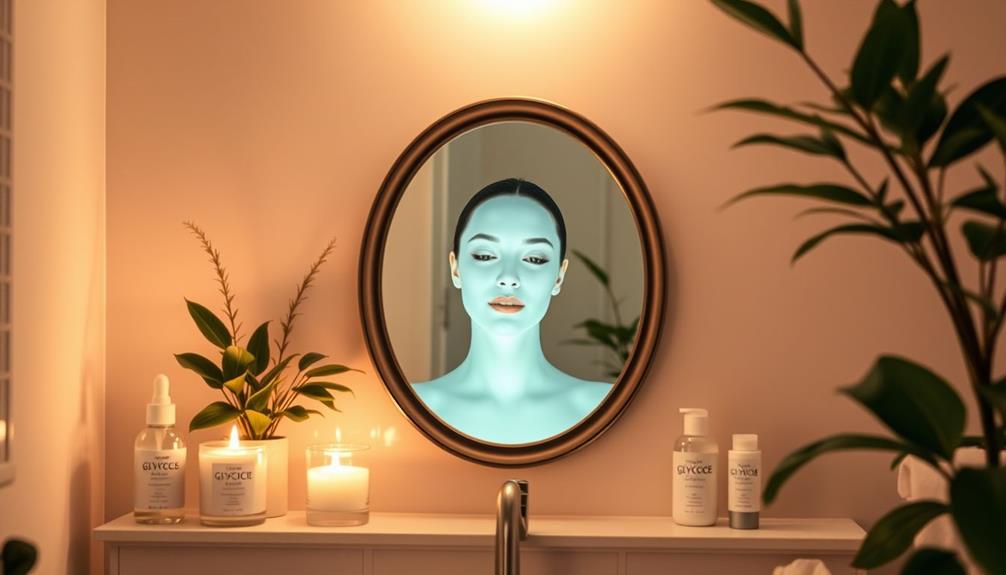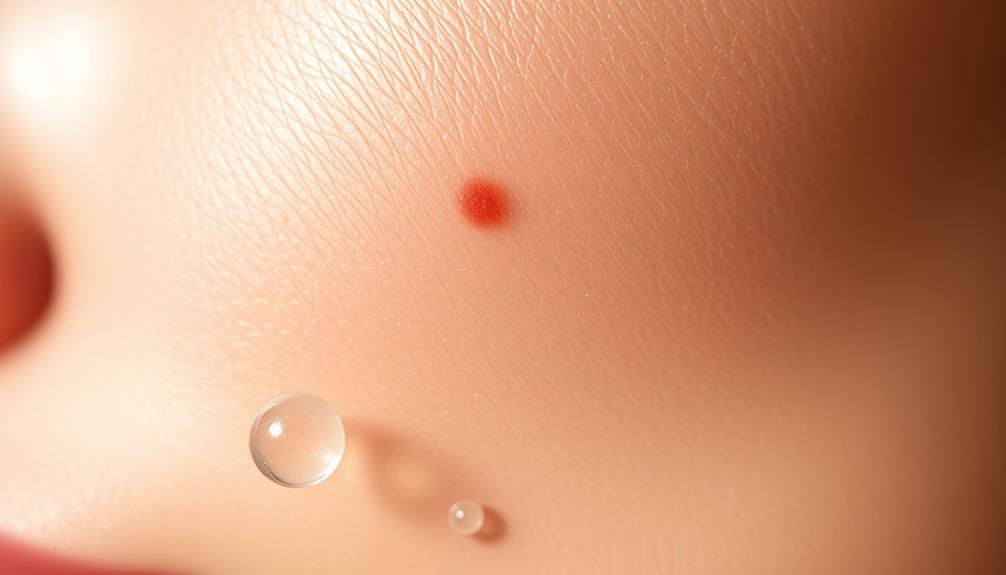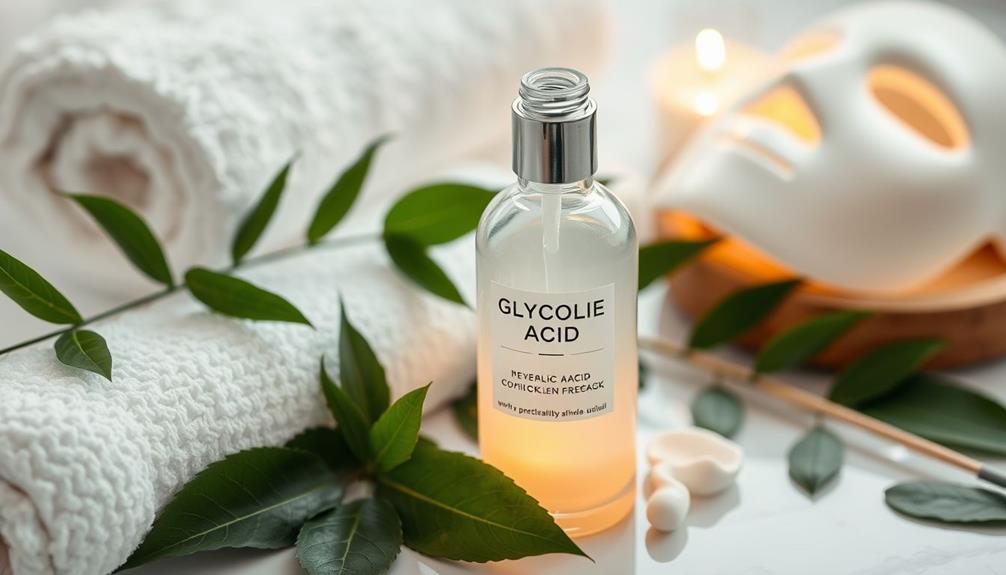Glycolic acid has the ability to enhance and soften your skin by deeply exfoliating dead skin cells and encouraging collagen production. Its small molecular size enables it to penetrate effectively, aiding in unclogging pores, diminishing dark spots, and enhancing overall texture. With regular use, you will notice a more uniform complexion and a radiant glow. It is recommended to start with a lower concentration to prevent irritation, particularly if you have sensitive skin. For optimal results, apply it at night and always remember to use sunscreen during the day. Continue to explore to find more advice on how to include this potent ingredient in your skincare regimen.
Key Takeaways
- Glycolic acid exfoliates dead skin cells, revealing a brighter and smoother complexion beneath.
- It reduces dark spots and hyperpigmentation by breaking down pigmented cell bonds.
- Regular use stimulates collagen production, enhancing skin texture and elasticity.
- Glycolic acid increases cell turnover, promoting fresher and healthier skin over time.
What Is Glycolic Acid?
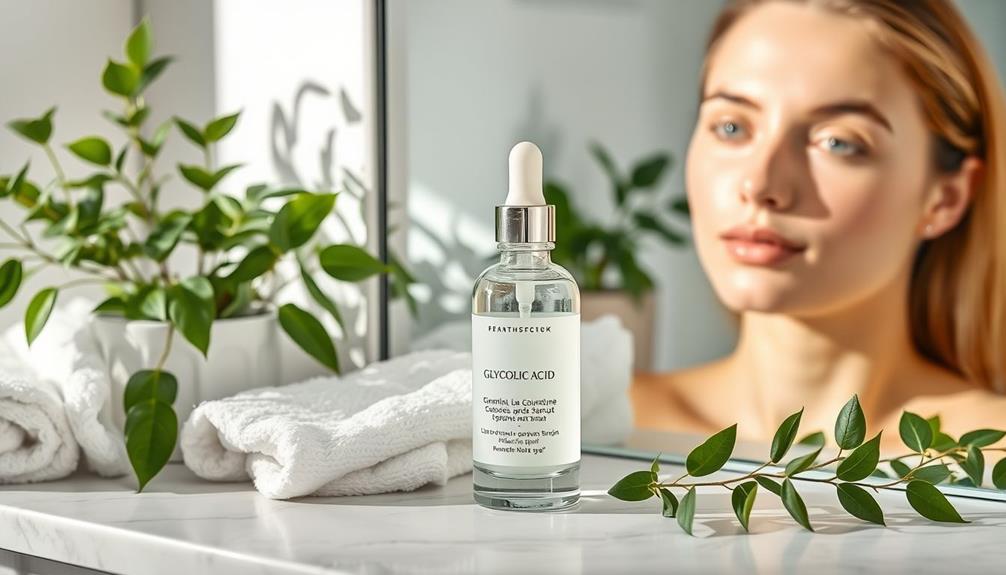
Glycolic acid is a powerful alpha hydroxy acid (AHA) derived from sugar cane, known for its ability to deeply exfoliate and rejuvenate your skin. This water-soluble acid has a small molecular size that allows it to penetrate your skin effectively.
When you use glycolic acid, it exfoliates by breaking down the bonds between dead skin cells, promoting cell turnover. This process reveals brighter, smoother skin that can enhance your overall complexion. Incorporating natural ingredients like essential oils for skin can also complement the effects of glycolic acid, providing additional nourishment and benefits to your skincare routine.
Regular application of glycolic acid can considerably reduce the appearance of fine lines and wrinkles. It stimulates collagen production, leading to improved skin texture and elasticity.
If you struggle with hyperpigmentation, this acid can help fade dark spots, contributing to a more even skin tone. Glycolic acid is particularly beneficial for oily and acne-prone skin; it unclogs pores, reduces breakouts, and helps you achieve a smoother overall appearance.
Incorporating glycolic acid into your skincare routine can brighten your skin while addressing common concerns such as uneven texture and signs of aging. It's a potent ingredient that can transform your skin, making it look revitalized and radiant.
Key Benefits for Your Skin
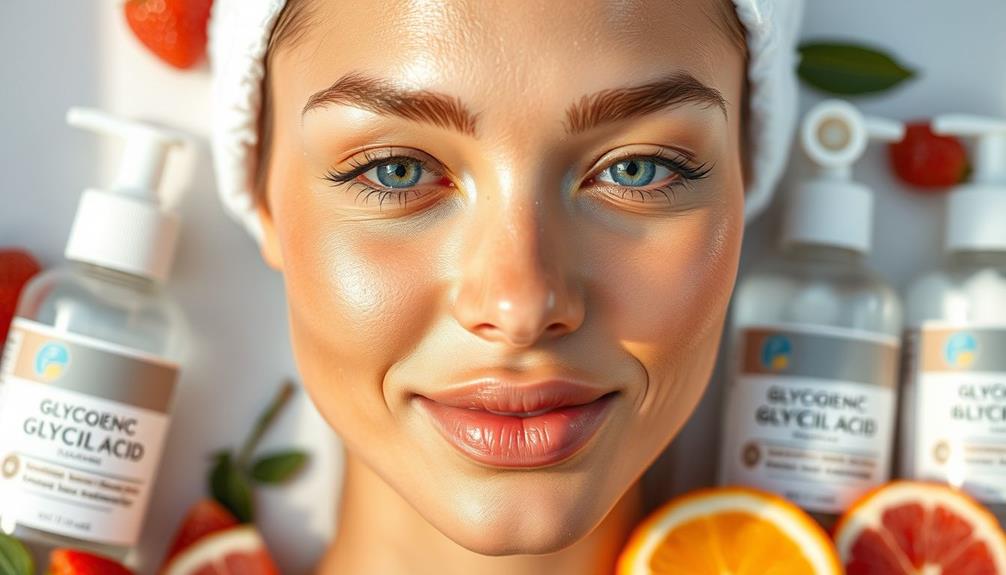
Experience brighter and more radiant skin with the key benefits of glycolic acid, which effectively exfoliates dead skin cells and promotes a clearer complexion.
Its powerful exfoliating properties allow it to break down the bonds holding pigmented cells together, greatly reducing dark spots and hyperpigmentation. As you incorporate glycolic acid into your routine, you'll notice a more even skin tone and a brighter complexion. Additionally, maintaining a consistent skincare routine can enhance the effects of glycolic acid, leading to improved overall skin health and texture. Consider integrating yoga for back pain relief practices, as they can help reduce stress that negatively impacts skin appearance.
Glycolic acid also plays an important role in stimulating collagen production, which helps smooth fine lines and wrinkles, enhancing your skin's texture. This boost in collagen not only improves skin elasticity but also contributes to a firmer, youthful appearance.
With its small molecular size, glycolic acid penetrates deeply into the skin, ensuring effective exfoliation and rejuvenation.
Regular use of glycolic acid can increase cell turnover, leading to fresher, healthier skin over time. By adopting this powerhouse ingredient, you're investing in a skincare solution that promises not just immediate results but lasting improvements in your skin's overall health and energy.
Embrace the transformative benefits of glycolic acid for a more luminous, youthful complexion.
How to Use Glycolic Acid
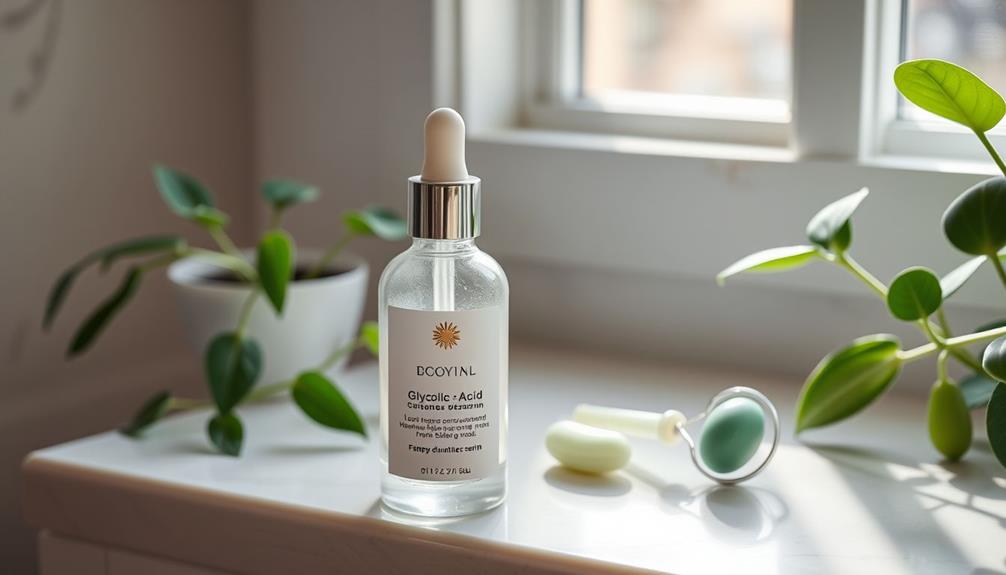
To effectively incorporate glycolic acid into your skincare routine, start with lower concentrations between 5-10%. This gradual approach helps your skin adapt and minimizes the risk of skin irritation.
Many individuals find that integrating self-exploration through body awareness can enhance their overall skincare experience by promoting a mindful connection with their skin.
Begin by applying glycolic acid products in the evening, allowing them to penetrate for a few minutes before layering other products. If you have sensitive skin, consider doing a patch test first to verify your skin reacts well.
Monitor the frequency of use, starting with once or twice a week. As your skin becomes accustomed to glycolic acid, you can slowly increase usage. It's crucial to follow up with a broad-spectrum sunscreen during the day, as glycolic acid can make your skin more sensitive to sunlight.
In your skincare routine, use a gentle, hydrating cleanser before applying glycolic acid to maintain moisture levels and reduce potential dryness.
Avoid using glycolic acid in conjunction with other exfoliating agents or retinoids to prevent over-exfoliation. By carefully managing how to use glycolic acid, you can enjoy its benefits while protecting your skin.
Always consult a dermatologist if you experience excessive redness or irritation.
Managing Side Effects

When you start using glycolic acid, it's vital to perform a patch test to guarantee it's compatible with your skin.
Additionally, incorporating essential oils for skin benefits can enhance your skincare routine.
Moisturizing after application helps prevent dryness and irritation, which can occur with this product.
Patch Testing Importance
Patch testing is essential for ensuring your skin can tolerate glycolic acid, helping you avoid potential redness or irritation.
Before fully incorporating glycolic acid into your routine, it's imperative to assess your skin's sensitivity, much like how auditory processing disorder techniques involve careful assessments to gauge sensitivity to sounds.
Here's how you can effectively perform a patch test:
- Choose a discreet area: Apply a small amount of the product behind your ear or on your inner arm.
- Start with a low concentration: Using a 5% glycolic acid can minimize the risk of irritation while gauging your skin's tolerance.
- Wait for 24-48 hours: Observe the area for any adverse reactions such as swelling, itching, or burning.
- Monitor your skin reactions: After introducing glycolic acid, keep an eye on how your skin responds over time.
Moisturizing After Application
Moisturizing after applying glycolic acid is essential for preventing dryness and irritation that can result from its exfoliating properties.
When you use glycolic acid, it can disrupt your skin's moisture barrier, leading to potential discomfort.
Regular skin care practices, such as incorporating regular vet check-ups for your pets, can help maintain overall well-being, which translates to healthier skin for you too.
To counteract this, choose a gentle, hydrating moisturizer that helps restore that barrier and provides necessary hydration.
Look for ingredients like humectants, such as hyaluronic acid, in your moisturizer.
These ingredients draw water into your skin, enhancing hydration and promoting skin comfort.
Applying your moisturizer shortly after glycolic acid will lock in moisture, maximizing the treatment's benefits while minimizing any side effects.
Regularly moisturizing not only helps alleviate dryness but also supports skin healing and improves overall texture.
By consistently hydrating your skin, you'll enhance the results of glycolic acid treatments, making your skin feel smoother and more radiant.
Remember, keeping your skin well-hydrated is key to enjoying the brightening effects of glycolic acid without experiencing irritation or discomfort.
Glycolic Acid for Different Skin Types

Glycolic acid caters to various skin types by addressing specific concerns, making it a versatile ingredient in your skincare routine. Here's how it benefits different skin types:
- Oily and Acne-Prone Skin: Glycolic acid unclogs pores and reduces excess sebum, leading to fewer breakouts and improved skin texture.
- Dry and Sensitive Skin: Start with lower concentrations (around 5%) to enjoy the exfoliating benefits while minimizing irritation and maintaining moisture retention.
- Normal Skin: You can enhance brightness and clarity by promoting cell turnover, reducing dark spots and hyperpigmentation.
- Sensitive Skin: Look for glycolic acid products with hydrating ingredients to prevent irritation and support moisture retention.
Comparing Glycolic Acid to Other AHAs
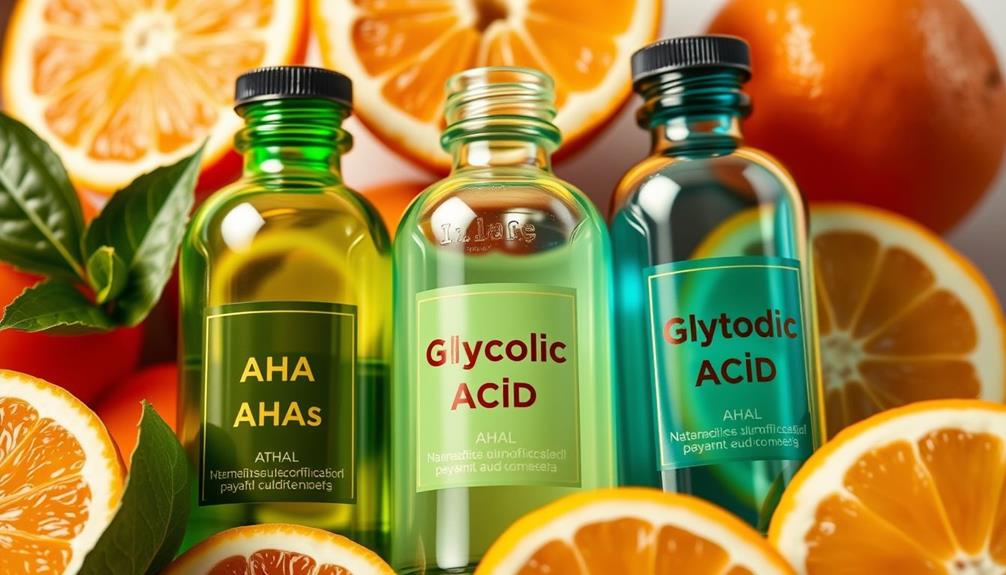
When exploring the benefits of glycolic acid, it's important to compare it with other alpha hydroxy acids (AHAs) to understand their unique properties and how they can complement your skincare routine.
Glycolic acid stands out due to its small molecular size, allowing for deeper penetration and more effective exfoliation. This makes it ideal for oily and acne-prone skin, especially when targeting fine lines and improving skin texture.
In contrast, lactic acid features larger molecules that provide gentler exfoliation, making it better suited for dry and sensitive skin. It offers hydration while still helping with exfoliation.
On the other hand, mandelic acid is the gentlest of the AHAs, thanks to its larger structure. This makes it a good option for sensitive skin types and those with darker skin tones, as it reduces the risk of irritation and hyperpigmentation.
While citric acid can help control oil production for normal to oily skin, it doesn't deliver the same level of exfoliating power as glycolic acid.
Depending on your skin's needs, you might choose glycolic acid for quick results or lactic and mandelic acids for gentler hydration.
Importance of Ph Balance
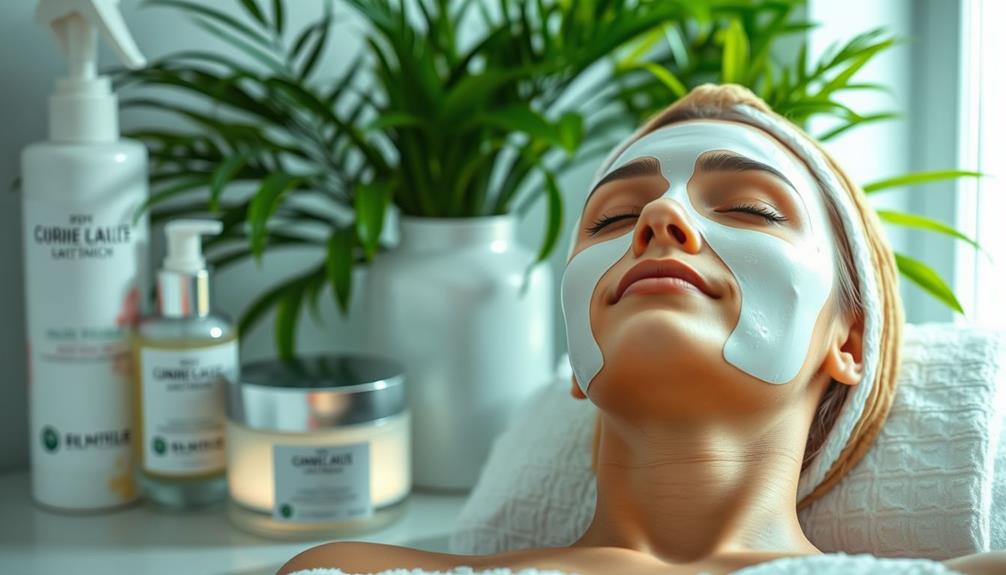
Maintaining the right pH balance is essential for maximizing the effectiveness of glycolic acid and ensuring your skin remains healthy and irritation-free. The ideal pH for glycolic acid lies between 3 and 4, which enhances its exfoliation properties while minimizing irritation.
To keep your skin's natural acidity intact, consider these tips:
- Use pH-balanced toners after applying glycolic acid to restore your skin's balance.
- Avoid alkaline products immediately after application to prevent neutralizing glycolic acid.
- Allow glycolic acid to penetrate the skin for a few minutes for maximum benefits.
- Incorporate a consistent pH balance into your skincare routine to support glycolic acid's stability.
Incorporating Glycolic Acid Into Your Routine

Incorporating glycolic acid into your routine can transform your skin by enhancing its texture and radiance. Start with a low concentration product (5-10%) to help your skin acclimate and minimize potential irritation.
Apply glycolic acid in the evening for maximum effectiveness and reduced sun sensitivity. It's essential to follow up with a broad-spectrum sunscreen during the day to protect your skin.
Use glycolic acid alongside a gentle, hydrating cleanser and a moisturizer to maintain skin hydration and prevent dryness after exfoliation. Begin with a frequency of use of once or twice a week, and pay close attention to how your skin reacts. Adjust the frequency as needed to achieve ideal results without irritation.
You can also enhance your routine by incorporating vitamin C during the day. Just make sure to keep glycolic acid products separate in your skincare routine to maximize the benefits of both ingredients.
This combination will aid in brightening your skin and improving its overall texture. By following these steps, you'll create a balanced approach to incorporating glycolic acid that promotes glowing, healthy skin.
Tips for Maximizing Results

To maximize the benefits of glycolic acid, stay consistent with your application and give your skin time to adjust. Start with a low concentration of around 5-10%. This gradual approach helps minimize irritation while allowing your skin to acclimate.
Here are some tips to enhance your results:
- Apply in the evening: This helps reduce sun sensitivity and allows glycolic acid to penetrate the skin effectively.
- Layer wisely: Wait a few minutes after applying glycolic acid before adding other skin care products like a moisturizer or serum to maximize its effectiveness.
- Hydrate: Use a gentle, pH-balanced cleanser and a hydrating moisturizer or serum to maintain moisture and reduce potential dryness.
- Be consistent: Regular use is key; improved brightness and smoothness may take weeks to appear, but persistence pays off.
Frequently Asked Questions
Does Glycolic Acid Brighten the Face?
Yes, glycolic acid brightens your face. It gently exfoliates, removing dead skin cells and promoting cell turnover. Over time, you'll notice a clearer, more radiant complexion as it improves your skin tone and texture.
How Fast Does Glycolic Acid Brighten Skin?
You'll notice glycolic acid brightening your skin within 4 to 6 weeks of regular use. Its exfoliating properties promote cell turnover, helping to reduce dark spots and improve your overall skin tone over time.
How Does Glycolic Acid Smooth Skin?
Glycolic acid's gentle grip gets you glowing! It exfoliates, eliminating dead cells and encouraging cell turnover. With regular use, it boosts collagen, enhancing elasticity, leaving your skin smooth, supple, and sensationally soft.
Does Glycolic Acid Make You Glow?
Yes, glycolic acid can make you glow! It exfoliates dead skin cells, boosts cell turnover, and promotes collagen production, revealing fresher, more radiant skin. Regular use can greatly enhance your complexion's brightness and overall appearance.
Conclusion
Incorporating glycolic acid into your skincare routine can brighten your complexion, smooth rough textures, and enhance your overall glow.
By understanding its benefits, learning how to use it properly, and being mindful of your skin's needs, you can access its full potential.
So, embrace the power of glycolic acid, enjoy the transformation, and watch your skin thrive.
With consistency and care, you're just steps away from achieving a radiant, youthful appearance that turns heads and boosts your confidence.

